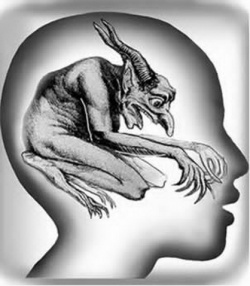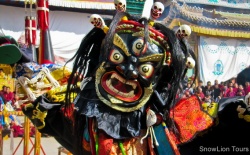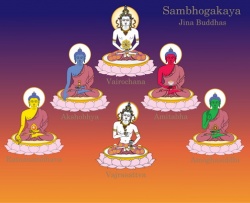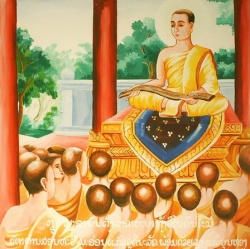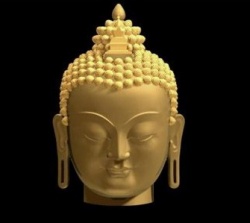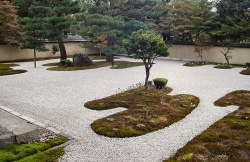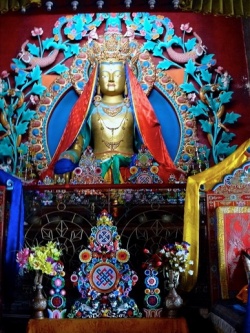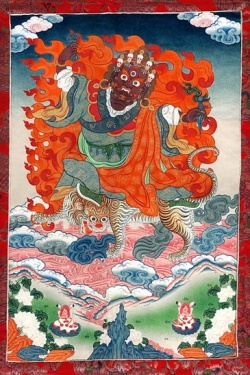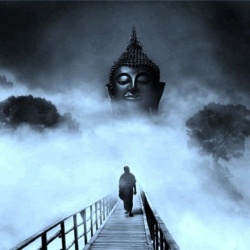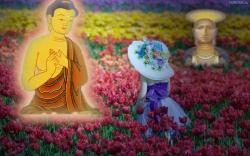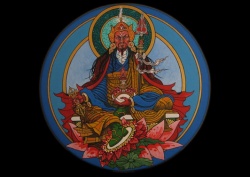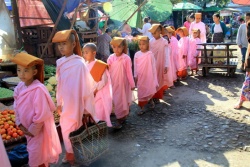Difference between revisions of "The Lineage of Tibetan Buddhist Tradition"
(Created page with "Today, on the occasion of the Second World Conference for the Propagation of Buddhism, in the capital of Thailand, {{Wiki|Bangkok}}, I consider it my great g...") |
|||
| Line 1: | Line 1: | ||
| + | <nomobile>{{DisplayImages|1252|545|1499|3613|1150|923|3629|1555|267|486|4068|3027|2886|4382|200}}</nomobile> | ||
| + | |||
| + | |||
| + | |||
| + | |||
Today, on the occasion of the Second [[World]] Conference for the [[Propagation]] of [[Buddhism]], in the capital of [[Thailand]], {{Wiki|Bangkok}}, I consider it my great [[good fortune]] to be {{Wiki|present}} at this [[gathering]], as a representative of [[Tibetan Buddhism]]. | Today, on the occasion of the Second [[World]] Conference for the [[Propagation]] of [[Buddhism]], in the capital of [[Thailand]], {{Wiki|Bangkok}}, I consider it my great [[good fortune]] to be {{Wiki|present}} at this [[gathering]], as a representative of [[Tibetan Buddhism]]. | ||
| − | Regarding the first among the five sets of proposals to a be presented at this Conference, I consider this to be a topic of the greatest importance, like the [[root]] within the five proposals, As followers of the same [[Teacher]], we are-meant to encompass each other with the {{Wiki|light}} of the [[jewel]] of [[pure]] outlook, putting aside any falling into {{Wiki|sectarianism}}, or contention between schools of [[tenets]] and [[yanas]] such as the [[Theravada]], [[Mahayana]], and [[Vajrayana]] which came into being through the unfolding of the [[enlightened activity]] of the [[Buddha]] in many different countries | + | Regarding the first among the five sets of proposals to a be presented at this Conference, I consider this to be a topic of the greatest importance, like the [[root]] within the five proposals, |
| + | |||
| + | As followers of the same [[Teacher]], we are-meant to encompass each other with the {{Wiki|light}} of the [[jewel]] of [[pure]] outlook, putting aside any falling into {{Wiki|sectarianism}}, | ||
| + | |||
| + | or contention between schools of [[tenets]] and [[yanas]] such as the [[Theravada]], [[Mahayana]], and [[Vajrayana]] which came into being through the unfolding of the [[enlightened activity]] of the [[Buddha]] in many different countries. | ||
| − | In order for us to come to a proper {{Wiki|egalitarian}} relationship of interconnectedness, among the different [[Buddhist]] denominations which is not merely pay lip-service, it is very important to be able to know mid have a full [[grasp]] of each other's view, [[meditation]], and conduct as they are, rather than holding in esteem our [[own]] [[tradition]] and completely rejecting, without clear {{Wiki|examination}}, the other [[traditions]], whether good or bad. | + | For this [[reason]] I would like to offer a few [[thoughts]] or reflections on this {{Wiki|matter}}. |
| + | |||
| + | In order for us to come to a proper {{Wiki|egalitarian}} relationship of interconnectedness, among the different [[Buddhist]] denominations which is not merely pay lip-service, it is very important to be able to know mid have a full [[grasp]] of each other's view, | ||
| + | |||
| + | [[meditation]], and conduct as they are, rather than holding in esteem our [[own]] [[tradition]] and completely rejecting, without clear {{Wiki|examination}}, the other [[traditions]], whether good or bad. | ||
| + | |||
| + | The [[essence]] of the [[teaching]] of the [[Sugatas]], the [[Four Seals]] of the transmitted [[precepts]], that all composite are [[impermanent]], all contaminations are [[suffering]], all [[Dharmas]] are [[empty]] and devoid of [[self]], and [[Nirvana]] is [[peace]]. | ||
| + | |||
| + | And then, the [[suffering]] of [[samsara]] is like the [[pain]] of an {{Wiki|illness}}; | ||
| + | |||
| + | the origination like the [[cause]] that makes it develop; the [[truth of the path]] like the treatment, | ||
| + | |||
| + | the antidote that overpowers the {{Wiki|illness}}; | ||
| + | |||
| + | and the [[truth]] of [[cessation]] like the well-being of being freed from the {{Wiki|illness}}. | ||
| + | |||
| + | Having [[acknowledged]] [[suffering]], the [[cause]] is to be given up, the [[truth]] of [[cessation]] is the [[attainment]] to be actualized and the [[truth of the path]] is to be followed. | ||
| + | |||
| + | There are also the 37 Aspects on the [[Path]] of [[Enlightenment]] and the 3 Higher Trainings. | ||
| + | |||
| + | We are unified in these and it is important that we all show [[respect]] for and [[appreciation]] of each other's [[traditions]]. | ||
| − | |||
Therefore I believe that it is of [[essential]] that those who previously did not understand clearly the view, [[meditation]] and [[action]] of the [[Buddhist tradition]] of [[Tibet]], should definitely come to know and comprehend it. | Therefore I believe that it is of [[essential]] that those who previously did not understand clearly the view, [[meditation]] and [[action]] of the [[Buddhist tradition]] of [[Tibet]], should definitely come to know and comprehend it. | ||
| − | Nowadays it seems that some [[people]] have the wrong [[idea]] that [[Tibetan Buddhism]] is an invention of [[Tibetan]] [[lamas]]. Lacking [[understanding]] of the situation, they think that the teachings are not the [[pure]] [[teachings of the Buddha]]. It is most important to clarify this {{Wiki|misconception}}. | + | Nowadays it seems that some [[people]] have the wrong [[idea]] that [[Tibetan Buddhism]] is an invention of [[Tibetan]] [[lamas]]. |
| + | |||
| + | Lacking [[understanding]] of the situation, they think that the teachings are not the [[pure]] [[teachings of the Buddha]]. | ||
| + | |||
| + | It is most important to clarify this {{Wiki|misconception}}. | ||
| − | In a [[Sutra]], the [[Buddha]] predicted that at some point in the {{Wiki|future}} the teachings would flourish in the [[North]] and in the [[South]] | + | In a [[Sutra]], the [[Buddha]] predicted that at some point in the {{Wiki|future}} the teachings would flourish in the [[North]] and in the [[South]]. |
| − | + | In the [[North]], in [[Tibet]], this happened since the time of the [[Tibetan's]] [[Dharma King]] [[Songtsen Gampo]] in the 7th. Century. | |
| − | + | Later in the 8th. Century, the [[Tibet's]] 2nd. greatest [[Dharma King]] [[Trisong Deutsen]], an [[emanation]] of the [[Bodhisattva Manjushri]], invited the [[Buddhist Master]], [[Padmasambhava]] of [[India]], to his country. | |
| − | + | Subsequently, many [[Tibetan]] [[translators]] undertook the arduous journey to [[India]] at great personal [[risk]], travelling for months and undergoing great {{Wiki|hardships}} such as treacherous [[paths]], the scorching beat and attacks by {{Wiki|robbers}}. | |
| − | + | Upon arrival in [[India]] they sat as [[humble]] students at the feet of great and famous [[scholars]] and accomplished practitioners, at the [[monastic]] [[universities]] of [[Nalanda]] and [[Vikramashila]] and others. | |
| − | + | They studied [[Sanskrit]] for many years and translated into [[Tibetan]] the [[Sutras]], [[Vinaya]], [[Abhidharma]], as well as the [[tantras]] and commentaries. | |
| − | The [[Tibetan masters]] devoted their entire [[lives]] to {{Wiki|learning}}, contemplation and [[meditation]]. In addition, based on the [[Kangyur]] and the [[Tengyur]], they wrote many hundreds of texts in order to further clarify and maintain the [[precious]] [[teachings of the Buddha]]. They transmitted the [[Buddhadharma]] to thousands of [[monks and nuns]]. But they never tried to alter the [[doctrine]] of the [[Buddha]] or to invent a new [[Dharma]]. | + | Likewise many [[Indian]] [[scholars]] were invited to [[Tibet]] by the [[religious kings]] to oversee translations, thus ensuring their accuracy. |
| + | |||
| + | Thus, by means of [[teaching]], {{Wiki|learning}} and [[meditating]], over a period of thirteen hundred years a great [[development]] of [[Buddhism]] occurred in [[Tibet]]. | ||
| + | |||
| + | The hundred volumes of teachings known as the [[Tripitaka]] make up the [[doctrine]] of the kind [[teacher]] [[Buddha Shakyamuni]] and in the [[Tibetan]] translation are known as the [[Kangyur]]. | ||
| + | |||
| + | The two hundred and thirteen main commentaries by [[Indian]] [[scholars]] and [[siddhas]] on the [[Tripitaka]] in [[Tibetan]] are called the [[Tengyur]]. | ||
| + | |||
| + | The [[Tibetan Buddhist tradition]] is based exclusively on the [[Kangyur]] and the [[Tengyur]]. | ||
| + | |||
| + | The translations made between the 8th and 10th centuries CE are said to belong to the "[[early translation]]" school. | ||
| + | |||
| + | Those made from that time onwards by the [[translators]] [[Rinchen Zangpo]], [[Marpa]], Gö and others constitute the "[[new translation]]" school. | ||
| + | |||
| + | All of these many translations were made from [[Sanskrit]] and not from [[Pali]]. | ||
| + | |||
| + | To emphasise their authenticity the original titles of the texts and commentaries of the [[Tripitaka]] have been left in [[Sanskrit]]. | ||
| + | |||
| + | When {{Wiki|present}} day [[scholars]] compare the. same text in the original [[Sanskrit]] with its [[Tibetan]] translation, they are amazed by the accuracy and the absence of error. | ||
| + | |||
| + | Between the 7th and 17th centuries CE, the number of important [[Indian]] [[translators]] and [[scholars]] who traveled to [[Tibet]] is estimated to be one hundred and twenty-eight, and the main [[Tibetan]] [[translators]] visiting [[India]] about seventy six. | ||
| + | |||
| + | Their interpretations of the [[Kangyur]] and [[Tengyur]] were not influenced by {{Wiki|cultural}} bias neither was their approach at all [[superficial]]. | ||
| + | |||
| + | The [[Tibetan masters]] devoted their entire [[lives]] to {{Wiki|learning}}, contemplation and [[meditation]]. | ||
| + | |||
| + | In addition, based on the [[Kangyur]] and the [[Tengyur]], they wrote many hundreds of texts in order to further clarify and maintain the [[precious]] [[teachings of the Buddha]]. | ||
| + | |||
| + | They transmitted the [[Buddhadharma]] to thousands of [[monks and nuns]]. | ||
| + | |||
| + | But they never tried to alter the [[doctrine]] of the [[Buddha]] or to invent a new [[Dharma]]. | ||
In [[India]] during the early years of the dissemination of the [[Buddha's teachings]], four separate [[Buddhist philosophy]] schools developed. They were: [[Vaibhasika]], [[Sautantrika]], [[Cittamatra]] and [[Madhyamika]]. | In [[India]] during the early years of the dissemination of the [[Buddha's teachings]], four separate [[Buddhist philosophy]] schools developed. They were: [[Vaibhasika]], [[Sautantrika]], [[Cittamatra]] and [[Madhyamika]]. | ||
| − | The [[Vaibhasika]] subsequently divided into 18 [[traditions]], which were four main schools: | + | The [[Vaibhasika]] subsequently divided into 18 [[traditions]], which were four main schools: |
| − | In the 8th. Century CE the supreme [[abbot]] [[Shantarakshita]], a [[lineage]] holder of the [[Mulasarvastivada]] school, was invited to teach in [[Tibet]]. After some time twelve [[fully ordained]] [[Indian]] [[monks]] from the [[monastic]] {{Wiki|university}} of [[Vikramashila]] were also invited to [[Tibet]] to act as the ordaining assembly for a select group of seven [[Tibetan]] men, chosen to be the first [[monastics]] ever [[ordained]] in [[Tibet]], Subsequently they [[ordained]] a further three hundred. Thus the [[Tibetan]] [[Vinaya]] derives solely from the [[Indian]] [[Mulasarvastivada]] school. Only these [[four schools]], three of the [[Sthaviravada]] and [[Mulasarvastivada]] have continued until today, whereas the rest 14 [[traditions]] eventually wanded and disappeared. | + | [[Mulasarvastivadin]], [[Mahasamghika]], [[Sthaviravada]] and [[Sammitiya]], as well as further fourteen sub-schools, branched from these four main ones. |
| + | |||
| + | One of them, the [[Sthaviravada]] known in [[Pali]] as [[Theravada]], is followed today by [[monastics]] in [[India]], [[Burma]], [[Thailand]], [[Sri Lanka]], etc. | ||
| + | |||
| + | In the 8th. Century CE the supreme [[abbot]] [[Shantarakshita]], a [[lineage]] holder of the [[Mulasarvastivada]] school, was invited to teach in [[Tibet]]. After some time twelve [[fully ordained]] [[Indian]] [[monks]] from the [[monastic]] {{Wiki|university}} of [[Vikramashila]] | ||
| + | |||
| + | were also invited to [[Tibet]] to act as the ordaining assembly for a select group of seven [[Tibetan]] men, chosen to be the first [[monastics]] ever [[ordained]] in [[Tibet]], Subsequently they [[ordained]] a further three hundred. | ||
| + | |||
| + | Thus the [[Tibetan]] [[Vinaya]] derives solely from the [[Indian]] [[Mulasarvastivada]] school. Only these [[four schools]], three of the [[Sthaviravada]] and [[Mulasarvastivada]] have continued until today, whereas the rest 14 [[traditions]] eventually wanded and disappeared. | ||
The [[precepts]] for the [[Sthaviravada]] [[Vinaya]] fully-ordained [[monks]] are 227. They are divided into several different classes: | The [[precepts]] for the [[Sthaviravada]] [[Vinaya]] fully-ordained [[monks]] are 227. They are divided into several different classes: | ||
| + | |||
| + | <poem> | ||
4 defeats | 4 defeats | ||
13 remainders | 13 remainders | ||
| Line 40: | Line 112: | ||
75 faults | 75 faults | ||
7 practices that pacify conflicts. | 7 practices that pacify conflicts. | ||
| + | |||
| + | |||
On the other hand, the [[precepts]] for the [[Mulasarvastivada Vinaya]] fully-ordained [[monks]] are 253. They are also divided into several different categories: | On the other hand, the [[precepts]] for the [[Mulasarvastivada Vinaya]] fully-ordained [[monks]] are 253. They are also divided into several different categories: | ||
| + | |||
| + | |||
4 defeats | 4 defeats | ||
13 remainders | 13 remainders | ||
| Line 49: | Line 125: | ||
4 {{Wiki|individual}} confessions | 4 {{Wiki|individual}} confessions | ||
112 faults. | 112 faults. | ||
| + | </poem> | ||
| + | |||
| + | |||
| + | So there are small differences between the two schools. | ||
| + | |||
| + | For example, among the 112 faults in the [[Mulasarvastivada]] system, there are 7 concerning the wearing of the lower garment. In the [[Sthaviravada]] system, this [[subject]] appears as only one fault. | ||
| + | |||
| + | But as these examples show, although there are minor differences among the schools, regarding the [[root]] [[precepts]] they are [[identical]]. | ||
| + | |||
| + | Likewise, there are differences in the background stories giVenerable When the [[Mulasarvastivada Vinaya]] texts expound on the downfall of "Carrying wool", they recount the travelling of six [[monks]] to [[Nepal]] in some detail. | ||
| − | + | The [[Sthaviravada]] mention only their travelling to a country in the [[North]]. | |
| − | |||
| − | |||
| − | Concerning the [[Pitaka]] of the {{Wiki|holy}} teachings of the [[Vinaya]], translated into the [[Tibetan language]] drawn from the [[Tripitaka]], the [[teachings of the Buddha]], there are three parts: the [[Root]] [[Sutra]], the [[Sutra]] of the [[Expositions]] and the [[Sutra]] of Similar Class. Within the first, the [[Root]] [[Sutra]], are found the texts of the [[Bhikshu]] [[Pratimoksha]] and the [[Bhikshuni]] [[Pratimoksha]]. The [[Bhikshu]] [[Pratimoksha]] presents in brief the 253 {{Wiki|rules}} of a [[Bhikshu]]. The [[Pratimoksha Sutra]] for females shown in brief the 364 {{Wiki|rules}} for [[Bhikshunis]]. | + | Further differences are that the [[Mulasarvastivada]] considers being an albino as an [[obstacle]] to receiving [[vows]], while the [[Sthaviravada]] does not mention this; and when the [[Mulasarvastivada]] school maintains that at the time of [[ordination]] only head and moustache need to be shaved, while one of the other school includes also the [[eyebrows]]. |
| + | |||
| + | Also in the [[Sthaviravada]] schools, when a [[novice monk]] breaks any one of the 10 {{Wiki|novice}} [[precepts]], his [[vow]] is broken but it is not a defeat, which means that he can take back that [[precept]] and return to his previous {{Wiki|novice}} {{Wiki|status}}. | ||
| + | |||
| + | But in the [[Mulasarvastivada]] school, once a [[novice monk]] breaks any one of the four defeats which are included in the ten {{Wiki|novice}} [[precepts]], he is defeated and not allowed to take that [[precept]] back and return to the {{Wiki|status}} of a {{Wiki|novice}}. So there are some differences such as these. | ||
| + | |||
| + | Concerning the [[Pitaka]] of the {{Wiki|holy}} teachings of the [[Vinaya]], translated into the [[Tibetan language]] drawn from the [[Tripitaka]], the [[teachings of the Buddha]], | ||
| + | |||
| + | there are three parts: the [[Root]] [[Sutra]], the [[Sutra]] of the [[Expositions]] and the [[Sutra]] of Similar Class. | ||
| + | |||
| + | Within the first, the [[Root]] [[Sutra]], are found the texts of the [[Bhikshu]] [[Pratimoksha]] and the [[Bhikshuni]] [[Pratimoksha]]. | ||
| + | |||
| + | The [[Bhikshu]] [[Pratimoksha]] presents in brief the 253 {{Wiki|rules}} of a [[Bhikshu]]. The [[Pratimoksha Sutra]] for females shown in brief the 364 {{Wiki|rules}} for [[Bhikshunis]]. | ||
Secondly, in the [[Sutra]] of the [[Expositions]] there are [[four parts]]; these are: the Basic [[Scripture]] ([[agama]]), the Explanatory [[Scripture]], the Minor Instructions and the [[Transmission]] of the [[Sublime]] [[Teaching]]. | Secondly, in the [[Sutra]] of the [[Expositions]] there are [[four parts]]; these are: the Basic [[Scripture]] ([[agama]]), the Explanatory [[Scripture]], the Minor Instructions and the [[Transmission]] of the [[Sublime]] [[Teaching]]. | ||
| − | |||
| − | The basis for the [[actions]] in [[Vinaya]] is 121 procedure. In short there are three: the {{Wiki|ceremony}} of requesting, which is informing the [[Sangha]]; the request and the {{Wiki|ceremony}} of the two, which means to inform but ask if there is any objection. And then, there is the requesting and the {{Wiki|ceremony}} of the four which is the completion of the entire procedure. | + | Among the categories of the Basic [[Scripture]] are 17 fundamental pronouncements. |
| + | |||
| + | These are called fundamental because they support the [[three trainings]]: [[ethics]], [[concentration]] and [[wisdom]]. | ||
| + | |||
| + | The basis for completely [[cultivating]] the trainings is threefold: the {{Wiki|ceremony}} of restoration of [[vows]] ([[Posadha]]), the [[summer retreat]] ([[Varsha]]) and the {{Wiki|ceremony}} of releasing from its [[vows]]. | ||
| + | |||
| + | The basis for the [[conditions]] for remaining at ease are twofold: the basis of clothing and of [[medicine]]. | ||
| + | |||
| + | As to the basis of clothing there are three aspects: they are coarse blankets, garments and hide or leather. | ||
| + | |||
| + | As to the basic {{Wiki|medicines}}, there are four aspects: they are appropriate times, a suitable span of time, weekly permission and fitting to be kept for the whole of one's [[life]]. | ||
| + | |||
| + | The basis for the [[actions]] in [[Vinaya]] is 121 procedure. | ||
| + | |||
| + | In short there are three: the {{Wiki|ceremony}} of requesting, which is informing the [[Sangha]]; the request and the {{Wiki|ceremony}} of the two, which means to inform but ask if there is any objection. And then, there is the requesting and the {{Wiki|ceremony}} of the four which is the completion of the entire procedure. | ||
Regarding the basis of reparation in order to {{Wiki|purify}} [[moral]] downfalls, there are [[three divisions]]: the [[cause]] of [[abandoning]] the [[vows]], restoring the downfalls, and mending [[disputes]]. | Regarding the basis of reparation in order to {{Wiki|purify}} [[moral]] downfalls, there are [[three divisions]]: the [[cause]] of [[abandoning]] the [[vows]], restoring the downfalls, and mending [[disputes]]. | ||
| Line 68: | Line 177: | ||
There is also [[abandoning]] the [[two extremes]] concerned with dwelling places. Altogether these are the 17 fundamental pronouncements. | There is also [[abandoning]] the [[two extremes]] concerned with dwelling places. Altogether these are the 17 fundamental pronouncements. | ||
| − | Concerning the [[Sutra]] of the Explanatory [[Scripture]], there are {{Wiki|male}} and {{Wiki|female}} classifications. As to the {{Wiki|male}} {{Wiki|classification}}, there are the 253 [[precepts]] of a [[Bhikshu]] and many teachings on {{Wiki|training}}. It also shows extensively the 7 [[Dharma]] which pacify contention. As to the {{Wiki|female}} {{Wiki|classification}}, there are the eight classes of defeat, the 20 remainders, the 33 [[abandoning]] downfalls, the 180 downfalls, the 11 {{Wiki|individual}} confessions, the 112 faults and many [[Dharmas]] on [[discipline]]. It also shows extensively the 7 [[Dharmas]] for pacifying contention. | + | Concerning the [[Sutra]] of the Explanatory [[Scripture]], there are {{Wiki|male}} and {{Wiki|female}} classifications. |
| + | |||
| + | As to the {{Wiki|male}} {{Wiki|classification}}, there are the 253 [[precepts]] of a [[Bhikshu]] and many teachings on {{Wiki|training}}. | ||
| + | |||
| + | It also shows extensively the 7 [[Dharma]] which pacify contention. As to the {{Wiki|female}} {{Wiki|classification}}, | ||
| + | |||
| + | there are the eight classes of defeat, the 20 remainders, the 33 [[abandoning]] downfalls, the 180 downfalls, the 11 {{Wiki|individual}} confessions, the 112 faults and many [[Dharmas]] on [[discipline]]. | ||
| + | |||
| + | It also shows extensively the 7 [[Dharmas]] for pacifying contention. | ||
The Minor Instructions are a commentary which gives the general meanings of the two Pratimokshas by extensively putting in order the minor points which reside in the [[discipline]]. | The Minor Instructions are a commentary which gives the general meanings of the two Pratimokshas by extensively putting in order the minor points which reside in the [[discipline]]. | ||
| Line 74: | Line 191: | ||
The [[Sublime]] [[Teaching]] [[Sutra]] is the last and most cherished commentary since it resolves and teaches the meanings of the first three [[Vinaya]] texts which are profound and difficult to understand. | The [[Sublime]] [[Teaching]] [[Sutra]] is the last and most cherished commentary since it resolves and teaches the meanings of the first three [[Vinaya]] texts which are profound and difficult to understand. | ||
| + | <poem> | ||
The [[Sutra]] of Similar Class includes: | The [[Sutra]] of Similar Class includes: | ||
The [[Sutra]] which Annihilates the Breaking of [[Ethical]] Conduct | The [[Sutra]] which Annihilates the Breaking of [[Ethical]] Conduct | ||
| Line 82: | Line 200: | ||
The [[Sutra]] on the Occasions for Use of the [[Gong]] | The [[Sutra]] on the Occasions for Use of the [[Gong]] | ||
The [[Sutra]] for Possessing Perfect [[Moral Discipline]], and so forth. | The [[Sutra]] for Possessing Perfect [[Moral Discipline]], and so forth. | ||
| + | </poem> | ||
| + | |||
| + | |||
| + | Previous to 1959 CE, thousands of [[monasteries]] and [[nunneries]] existed in [[Tibet]]. [[Ordained]] [[Sangha]] in various numbers dwelled in them. In the larger [[monasteries]] there were thousands of [[monks]], hundreds in the average ones and some ten or so in the smaller ones. | ||
| + | |||
| + | Among these were [[monastic]] centers of [[nuns]] and [[monasteries]] of [[upasaka]] vow-holders. However most were [[monasteries]] containing [[Shramanera]] and [[Bhikshu]]. | ||
| + | |||
| + | This majority abided in the [[Wikipedia:Authenticity|authentic]] [[observance]] of the three basic [[precepts]] of the [[Vinaya]]: the [[Summer Retreat]], the {{Wiki|ceremony}} for releasing its {{Wiki|rules}} and the [[Posadha]] {{Wiki|ceremony}} for restoring the [[vows]]. | ||
| + | |||
| + | In the second millennium the [[Buddhist Sangha]] of [[Tibet]] upheld one of the [[Pratimoksha]] [[traditions]], but at the time of the {{Wiki|Cultural Revolution}} in [[Tibet]], they went into {{Wiki|decline}}. | ||
| + | |||
| + | Nevertheless at {{Wiki|present}}, the [[Tibetan]] [[Sangha]] who abide in [[India]] and [[Nepal]], are upholding and preserving the [[Pratimoksha]] [[doctrine]] as before. | ||
| + | |||
| + | In that way, without transgressing the intent of these four classes of [[scriptures]] on the [[monastic discipline]], the [[Tibetan]] [[Sangha]] uphold the [[Vinaya]] and, as well as never having failed in the [[observance]] of the [[Vinaya]], | ||
| + | |||
| + | also take on the [[Bodhisattva vows]] and the [[vows]] of [[Vajrayana]] and therefore perform the practice of the three [[Dharmas]] - [[Pratimoksha]], [[Bodhisattva]] and [[Vajrayana]]. | ||
| + | |||
| + | Those with an [[intellect]] that narrowly clings to partiality like the "gaze of a one eyed man", might maintain that the [[Pratimoksha]], [[Bodhisattva]] and [[Tantric vows]] contradict each other. | ||
| − | + | This is due to [[seeing]] these as classifications and not perceiving their true [[intention]], in which there is never a {{Wiki|contradiction}}. | |
| − | + | It is explained at the level of [[Pratimoksha]], [[Bodhisattva]] or [[Tantra]] that the [[cause]] of being [[bound]] to the [[three realms]] of [[samsara]] is the [[actions]] of the [[three doors]] which are under the influence of the [[negative emotions]] or [[kleshas]], | |
| − | + | such as [[desire]], [[aversion]], and so forth. According to the [[Pratimoksha]] of the [[shravakas]], by . | |
{{R}} | {{R}} | ||
http://www.dorzongrinpoche.org/texts02.htm | http://www.dorzongrinpoche.org/texts02.htm | ||
[[Category:Lineage]] | [[Category:Lineage]] | ||
Revision as of 17:11, 7 February 2016
Today, on the occasion of the Second World Conference for the Propagation of Buddhism, in the capital of Thailand, Bangkok, I consider it my great good fortune to be present at this gathering, as a representative of Tibetan Buddhism.
Regarding the first among the five sets of proposals to a be presented at this Conference, I consider this to be a topic of the greatest importance, like the root within the five proposals,
As followers of the same Teacher, we are-meant to encompass each other with the light of the jewel of pure outlook, putting aside any falling into sectarianism,
or contention between schools of tenets and yanas such as the Theravada, Mahayana, and Vajrayana which came into being through the unfolding of the enlightened activity of the Buddha in many different countries.
For this reason I would like to offer a few thoughts or reflections on this matter.
In order for us to come to a proper egalitarian relationship of interconnectedness, among the different Buddhist denominations which is not merely pay lip-service, it is very important to be able to know mid have a full grasp of each other's view,
meditation, and conduct as they are, rather than holding in esteem our own tradition and completely rejecting, without clear examination, the other traditions, whether good or bad.
The essence of the teaching of the Sugatas, the Four Seals of the transmitted precepts, that all composite are impermanent, all contaminations are suffering, all Dharmas are empty and devoid of self, and Nirvana is peace.
And then, the suffering of samsara is like the pain of an illness;
the origination like the cause that makes it develop; the truth of the path like the treatment,
the antidote that overpowers the illness;
and the truth of cessation like the well-being of being freed from the illness.
Having acknowledged suffering, the cause is to be given up, the truth of cessation is the attainment to be actualized and the truth of the path is to be followed.
There are also the 37 Aspects on the Path of Enlightenment and the 3 Higher Trainings.
We are unified in these and it is important that we all show respect for and appreciation of each other's traditions.
Therefore I believe that it is of essential that those who previously did not understand clearly the view, meditation and action of the Buddhist tradition of Tibet, should definitely come to know and comprehend it.
Nowadays it seems that some people have the wrong idea that Tibetan Buddhism is an invention of Tibetan lamas.
Lacking understanding of the situation, they think that the teachings are not the pure teachings of the Buddha.
It is most important to clarify this misconception.
In a Sutra, the Buddha predicted that at some point in the future the teachings would flourish in the North and in the South.
In the North, in Tibet, this happened since the time of the Tibetan's Dharma King Songtsen Gampo in the 7th. Century.
Later in the 8th. Century, the Tibet's 2nd. greatest Dharma King Trisong Deutsen, an emanation of the Bodhisattva Manjushri, invited the Buddhist Master, Padmasambhava of India, to his country.
Subsequently, many Tibetan translators undertook the arduous journey to India at great personal risk, travelling for months and undergoing great hardships such as treacherous paths, the scorching beat and attacks by robbers.
Upon arrival in India they sat as humble students at the feet of great and famous scholars and accomplished practitioners, at the monastic universities of Nalanda and Vikramashila and others.
They studied Sanskrit for many years and translated into Tibetan the Sutras, Vinaya, Abhidharma, as well as the tantras and commentaries.
Likewise many Indian scholars were invited to Tibet by the religious kings to oversee translations, thus ensuring their accuracy.
Thus, by means of teaching, learning and meditating, over a period of thirteen hundred years a great development of Buddhism occurred in Tibet.
The hundred volumes of teachings known as the Tripitaka make up the doctrine of the kind teacher Buddha Shakyamuni and in the Tibetan translation are known as the Kangyur.
The two hundred and thirteen main commentaries by Indian scholars and siddhas on the Tripitaka in Tibetan are called the Tengyur.
The Tibetan Buddhist tradition is based exclusively on the Kangyur and the Tengyur.
The translations made between the 8th and 10th centuries CE are said to belong to the "early translation" school.
Those made from that time onwards by the translators Rinchen Zangpo, Marpa, Gö and others constitute the "new translation" school.
All of these many translations were made from Sanskrit and not from Pali.
To emphasise their authenticity the original titles of the texts and commentaries of the Tripitaka have been left in Sanskrit.
When present day scholars compare the. same text in the original Sanskrit with its Tibetan translation, they are amazed by the accuracy and the absence of error.
Between the 7th and 17th centuries CE, the number of important Indian translators and scholars who traveled to Tibet is estimated to be one hundred and twenty-eight, and the main Tibetan translators visiting India about seventy six.
Their interpretations of the Kangyur and Tengyur were not influenced by cultural bias neither was their approach at all superficial.
The Tibetan masters devoted their entire lives to learning, contemplation and meditation.
In addition, based on the Kangyur and the Tengyur, they wrote many hundreds of texts in order to further clarify and maintain the precious teachings of the Buddha.
They transmitted the Buddhadharma to thousands of monks and nuns.
But they never tried to alter the doctrine of the Buddha or to invent a new Dharma.
In India during the early years of the dissemination of the Buddha's teachings, four separate Buddhist philosophy schools developed. They were: Vaibhasika, Sautantrika, Cittamatra and Madhyamika.
The Vaibhasika subsequently divided into 18 traditions, which were four main schools:
Mulasarvastivadin, Mahasamghika, Sthaviravada and Sammitiya, as well as further fourteen sub-schools, branched from these four main ones.
One of them, the Sthaviravada known in Pali as Theravada, is followed today by monastics in India, Burma, Thailand, Sri Lanka, etc.
In the 8th. Century CE the supreme abbot Shantarakshita, a lineage holder of the Mulasarvastivada school, was invited to teach in Tibet. After some time twelve fully ordained Indian monks from the monastic university of Vikramashila
were also invited to Tibet to act as the ordaining assembly for a select group of seven Tibetan men, chosen to be the first monastics ever ordained in Tibet, Subsequently they ordained a further three hundred.
Thus the Tibetan Vinaya derives solely from the Indian Mulasarvastivada school. Only these four schools, three of the Sthaviravada and Mulasarvastivada have continued until today, whereas the rest 14 traditions eventually wanded and disappeared.
The precepts for the Sthaviravada Vinaya fully-ordained monks are 227. They are divided into several different classes:
4 defeats
13 remainders
2 indefinite
30 abandoning downfalls
92 solitary downfalls
4 individual confessions
75 faults
7 practices that pacify conflicts.
On the other hand, the precepts for the Mulasarvastivada Vinaya fully-ordained monks are 253. They are also divided into several different categories:
4 defeats
13 remainders
2 indefinite
30 abandoning downfalls
90 solitary downfalls
4 individual confessions
112 faults.
So there are small differences between the two schools.
For example, among the 112 faults in the Mulasarvastivada system, there are 7 concerning the wearing of the lower garment. In the Sthaviravada system, this subject appears as only one fault.
But as these examples show, although there are minor differences among the schools, regarding the root precepts they are identical.
Likewise, there are differences in the background stories giVenerable When the Mulasarvastivada Vinaya texts expound on the downfall of "Carrying wool", they recount the travelling of six monks to Nepal in some detail.
The Sthaviravada mention only their travelling to a country in the North.
Further differences are that the Mulasarvastivada considers being an albino as an obstacle to receiving vows, while the Sthaviravada does not mention this; and when the Mulasarvastivada school maintains that at the time of ordination only head and moustache need to be shaved, while one of the other school includes also the eyebrows.
Also in the Sthaviravada schools, when a novice monk breaks any one of the 10 novice precepts, his vow is broken but it is not a defeat, which means that he can take back that precept and return to his previous novice status.
But in the Mulasarvastivada school, once a novice monk breaks any one of the four defeats which are included in the ten novice precepts, he is defeated and not allowed to take that precept back and return to the status of a novice. So there are some differences such as these.
Concerning the Pitaka of the holy teachings of the Vinaya, translated into the Tibetan language drawn from the Tripitaka, the teachings of the Buddha,
there are three parts: the Root Sutra, the Sutra of the Expositions and the Sutra of Similar Class.
Within the first, the Root Sutra, are found the texts of the Bhikshu Pratimoksha and the Bhikshuni Pratimoksha.
The Bhikshu Pratimoksha presents in brief the 253 rules of a Bhikshu. The Pratimoksha Sutra for females shown in brief the 364 rules for Bhikshunis.
Secondly, in the Sutra of the Expositions there are four parts; these are: the Basic Scripture (agama), the Explanatory Scripture, the Minor Instructions and the Transmission of the Sublime Teaching.
Among the categories of the Basic Scripture are 17 fundamental pronouncements.
These are called fundamental because they support the three trainings: ethics, concentration and wisdom.
The basis for completely cultivating the trainings is threefold: the ceremony of restoration of vows (Posadha), the summer retreat (Varsha) and the ceremony of releasing from its vows.
The basis for the conditions for remaining at ease are twofold: the basis of clothing and of medicine.
As to the basis of clothing there are three aspects: they are coarse blankets, garments and hide or leather.
As to the basic medicines, there are four aspects: they are appropriate times, a suitable span of time, weekly permission and fitting to be kept for the whole of one's life.
The basis for the actions in Vinaya is 121 procedure.
In short there are three: the ceremony of requesting, which is informing the Sangha; the request and the ceremony of the two, which means to inform but ask if there is any objection. And then, there is the requesting and the ceremony of the four which is the completion of the entire procedure.
Regarding the basis of reparation in order to purify moral downfalls, there are three divisions: the cause of abandoning the vows, restoring the downfalls, and mending disputes.
There is also abandoning the two extremes concerned with dwelling places. Altogether these are the 17 fundamental pronouncements.
Concerning the Sutra of the Explanatory Scripture, there are male and female classifications.
As to the male classification, there are the 253 precepts of a Bhikshu and many teachings on training.
It also shows extensively the 7 Dharma which pacify contention. As to the female classification,
there are the eight classes of defeat, the 20 remainders, the 33 abandoning downfalls, the 180 downfalls, the 11 individual confessions, the 112 faults and many Dharmas on discipline.
It also shows extensively the 7 Dharmas for pacifying contention.
The Minor Instructions are a commentary which gives the general meanings of the two Pratimokshas by extensively putting in order the minor points which reside in the discipline.
The Sublime Teaching Sutra is the last and most cherished commentary since it resolves and teaches the meanings of the first three Vinaya texts which are profound and difficult to understand.
The Sutra of Similar Class includes:
The Sutra which Annihilates the Breaking of Ethical Conduct
The Sutra of Nejok, the Discourse which is Essential for Monks
The Sutra of the Bhikshu's Staff
The Sutra which Teaches all the Manner of Holding the Staff
The Sutra of the Gandi (Wooden Gong)
The Sutra on the Occasions for Use of the Gong
The Sutra for Possessing Perfect Moral Discipline, and so forth.
Previous to 1959 CE, thousands of monasteries and nunneries existed in Tibet. Ordained Sangha in various numbers dwelled in them. In the larger monasteries there were thousands of monks, hundreds in the average ones and some ten or so in the smaller ones.
Among these were monastic centers of nuns and monasteries of upasaka vow-holders. However most were monasteries containing Shramanera and Bhikshu.
This majority abided in the authentic observance of the three basic precepts of the Vinaya: the Summer Retreat, the ceremony for releasing its rules and the Posadha ceremony for restoring the vows.
In the second millennium the Buddhist Sangha of Tibet upheld one of the Pratimoksha traditions, but at the time of the Cultural Revolution in Tibet, they went into decline.
Nevertheless at present, the Tibetan Sangha who abide in India and Nepal, are upholding and preserving the Pratimoksha doctrine as before.
In that way, without transgressing the intent of these four classes of scriptures on the monastic discipline, the Tibetan Sangha uphold the Vinaya and, as well as never having failed in the observance of the Vinaya,
also take on the Bodhisattva vows and the vows of Vajrayana and therefore perform the practice of the three Dharmas - Pratimoksha, Bodhisattva and Vajrayana.
Those with an intellect that narrowly clings to partiality like the "gaze of a one eyed man", might maintain that the Pratimoksha, Bodhisattva and Tantric vows contradict each other.
This is due to seeing these as classifications and not perceiving their true intention, in which there is never a contradiction.
It is explained at the level of Pratimoksha, Bodhisattva or Tantra that the cause of being bound to the three realms of samsara is the actions of the three doors which are under the influence of the negative emotions or kleshas,
such as desire, aversion, and so forth. According to the Pratimoksha of the shravakas, by .
